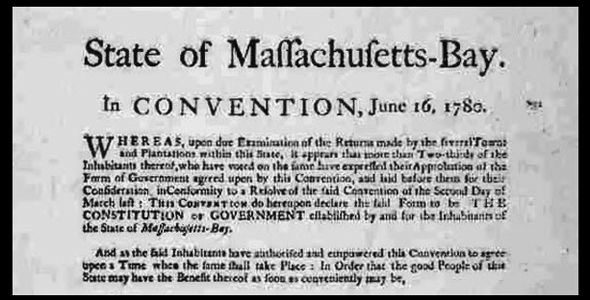Legal research in the Bay State
Researching the way Massachusetts was created as a matter of law through its chartering documents is really easy, isn’t it?
After all, The Legal Genealogist is quite sure that Massachusetts has only ever had one Constitution, adopted in 1780, now “the oldest functioning written constitution in continuous effect in the world.”1

So getting ready to talk about the law to bunches of Massachusetts genealogists on Cape Cod this Saturday — it’s a joint session of the Cape Cod Genealogical Society and the Falmouth Genealogical Society at St. Peter’s Episcopal Church in Osterville — should be a piece of cake, right?
Sigh… it’s never that easy. Not even in a place like Massachusetts.
Oh, it’s true that Massachusetts has only ever had one Constitution. And it was adopted in 1780. But:
• A constitutional convention held in 1820 resulted in the submission of 14 Articles of Amendment to popular vote in April of 1821, nine of which were adopted (and four of which have since been annulled by subsequent amendments).2
• A constitutional convention held in 1853 put together a new constitutional proposal, which was defeated by popular vote. But six amendments were adopted in 1854-55, one of which has since been superseded.3
• Another constitutional convention, in 1917-1918, sent a total of 21 amendments to the electorate — three in 1917 and 18 in 1918 — and all were passed. Bunches of them aren’t in effect today, though, because other later changes impacted those changes.4
• And in 1919 an editorial rearrangement of the entire Constitution was approved by the voters.5 Which was promptly held not to be the Constitution by the Supreme Judicial Court, the high court of Massachusetts, which said ultimately that “the Constitution of 1780 and its amendments are the fundamental law.”6
Is that complicated enough for you? How about if I add in the total-by-now of 120 amendments and all the ones proposed and not adopted?
And the purists out there are smiling smugly and noting that I started out with the Constitution of 1780, more than a century and a half after colonists began arriving in Massachusetts. I haven’t even mentioned the colonial charters yet…
Fortunately, for all of this, Massachusetts makes it as easy as it can be, for a rather complex topic.
The Massachusetts Constitution, with a comprehensive note as to amendments proposed and rejected, is set out at the Massachusetts legislature’s website.
And those colonial charters? Links to those are online too at a page compiled by the Massachusetts Trial Court Law Libraries on the Mass.gov website. In a section called “Documents 1620-1799,” you can find links to these chartering documents (and more):
• Mayflower Compact: Agreement Between the Settlers at New Plymouth, 1620.
• Charter of New England, 1620.
• Charter of the Colony of New Plymouth Granted to William Bradford and His Associates, 1629.
• Charter of Massachusetts Bay, 1629.
• Act of Surrender of the Great Charter of New England to His Majesty, 1635.
• Surrender of the Patent of Plymouth Colony to the Freeman, 1640.
• Commission of Sir Edmund Andros for the Dominion of New England, 1688.
• Charter of Massachusetts Bay, 1691.
• Explanatory Charter of Massachusetts Bay, 1725.
No, constituting Massachusetts, as a matter of law, ain’t easy.
But there is help… thank heavens…
SOURCES
- Wikipedia (http://www.wikipedia.com), “Constitution of Massachusetts,” rev. 10 Oct 2018. ↩
- “Note,” Massachusetts Constitution, General Court of the Commonwealth of Massachusetts (https://malegislature.gov/ : accessed 7 Nov 2018). ↩
- Ibid. ↩
- Ibid. ↩
- Ibid. ↩
- Loring v. Young, 239 Mass. 349, 375 (1921). See also Opinion of the Justices, 233 Mass. 603 (1920). ↩



We love our complicated okd state!
Thank you for a comprehensive list of resources. Another great blog post.